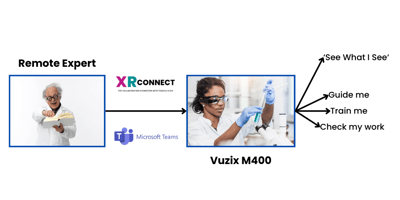Today Vuzix released 12 key findings with their new report on revolutionising fulfilment operations...
RealWear and Remote Experts - Why Use XRConnect?
This blog explains why Microsoft Teams and RealWear or Vuzix smart glasses need help to function fully in certain use cases, examples are:
- RealWear HMT-1 / RealWear 1Z1 in low bandwidth situations like the TD Williamson (Engineering) case study working on remote pipeline locations.
- With Vuzix M400 smart glasses in the medical sector where Microsoft Teams is part of the installed IT infrastructure but you have the need to collaborate with Remote Experts in a "one to one" or "one to many" situation.
- Other use cases and types would be
- Factory / Logistics / Warehousing operations where you are working in poor bandwidth conditions
- Construction where engineers are dialling into construction sites to carry out remote inspections and the site manager is walking the site to show levels of finishing or quality delivery. (CH Four Biogas)
What is XRconnect?
.png?width=300&height=300&name=XRconnect%20LOGO%20(1).png)
XRConnect is a powershell that Hardware Manufacturers like Vuzix, RealWear or Magic Leap can use to connect their hardware to Microsoft teams that is "tailored specifically" to the XR/AR marketplace.
Why wouldn't I just use Microsoft Teams?
Microsoft Teams is often the de facto collaboration choice for Microsoft Enterprise IT teams and that's a great choice, however there are some considerations when you are using AR/XR smart glasses:
- Teams can be very bandwidth demanding because its trying to optimise the quality of an HD video call.
- Particularly in four instances
- Where you want the smart glasses compute power to focus on running the software the glasses are using and not just the collaboration call.
- Where you want an HD quality call with many attendees in a "see what i see" use case and the smart glasses would struggle/fail to cope with multiple HD connections scenario.
- Where the field or location bandwidth is "not the best" and you still want an HD quality collaboration or "see what i see" connection.
- You want to maintain a Native Microsoft Teams call control environment - ie the users don't have to learn a new collaboration tool.
How has that been achieved?
- In 2013 some very clever engineers from Tandberg and Cisco, who had years of video hardware expertise left Cisco to form Pexip.
- Their mission, to create the best software video interoperability platform in the industry, using Software NOT Hardware, so that video hardware, webRTC browsers, Skype for Business and Google Meet could all talk to each other. No need to use someone else's collaboration tool, use what you have and use Pexip to effectively bridge the call.
- In those days Microsoft Teams was Skype for Business and even when it became Teams it used 25MB p/s per video channel. Most IT teams understand multiple attendees on Teams call using 25MB p/s knew that wouldn't scale.
- The Pexip engineers worked with Microsoft to lower their bandwidth usage, and when they got that down to a corporate bandwidth scalable level, Microsoft were happy. Pexip, however carried on, engineering the solution till they could attend a Microsoft Teams call and use only 100kbp/s of bandwidth. 250 times more bandwidth efficient than Microsoft's version 1.
- Critically they didn't sacrifice HD quality of the call.
- SimplyVideo use that Pexip interoperability, coupled it with Cloud storage, recording, voice controls and a simple User Interface to tailor it to XR/AR devices - hence XRConnect!

- The doc that describes this for IT teams is here
So let's explain the two key elements that any IT Team are going to discover in any head to head test, comparing connecting Microsoft Teams to AR/XR wearables and Connecting using XRConnect not just to Microsoft Teams, but Google Meet, a WebRTC browser, a Video hardware device.
What is XRConnect Interoperability, what can we connect?

Join a smart glasses session remotely "see what they see" using less bandwidth.
That's a short statement but anyone in IT knows thats just not easy or people would not have taken years to achieve it and thankfully they did before the world got hit by a global pandemic.
So that means:
Microsoft Teams users can join any XR devices session from Magic Leap, Vuzix or RealWear using XRConnect.
Google Meet users can do the same.
WebRTC browsers, Chrome lead the way can join a pair of glasses by clicking on a link.
Even largely legacy boardroom hardware devices can join a session in a pair of Smart Glasses
Thats what we call "the connect" part of what XRConnect delivers.
What is XRConnect's control capabilities?
No 1 the native controls of whatever you access by don't change
No 2 the XRConnect admin has a simple set of controls, for recording etc
No 3 the "wearables" enable participants can use Voice Controls/Commands to Zoom in etc
No 4 the bandwidth used is 100kbp/s per users/attendee, that's 20% of what a Teams call uses so XRConnect does not do the following:
- Consume lots of bandwidth
- Hamper the Smart Glasses/XR/AR glasses performance by demanding lots of compute or battery life
No 5 XRConnect therefore enables multiple attendees and low bandwidth scenario's because of its "bandwidth lite" characteristics.
No 6 Recording is easy, as is almost instant access to those recordings
No 7 Cloud Storage means large video files are stored in the cloud, not in your data centres as part of the subscription
No 8 If you run a private cloud high security policy the Pexip credentials ensure every IPSec box is not only ticked but welcomed as the Pexip engineers just loved the High Security challenge.
No 9 The Interface for the XRConnect user is simple to understand.
So how else does XRConnect help, practically?

No 1. Any wearables session where you want attendees to "see what i see" in any user case, site inspections, remote expert medical, educational student guidance or learning, they are all empowered by XRconnect.
No 2. Remote experts can attend a wearables session without lowering the battery life of the wearables devices and making them impractical.
No 3. Low bandwidth situations where the remote attendee would normally struggle like construction projects, engineering project or just in countries with low grade infrastructure then XRConnect users are equipping themselves with the best solution on the market bar NONE.
No 4. XRConnect has been engineered not to stress wearables devices compute levels, so the Smart Glasses will come into their own.
No 5 Enables multiple video channels to join the smart glasses wearer and "see what they see" without stressing the battery life of the smart glasses and making them impractical.
The video below is an engineering use case, TD Williamson who work on engineering large pipelines, containing pressurised gases.
- The video takes you through why they choose SimplyVideo to use with their Realwear Navigator 500 and HMT 1Z1 smart glasses.
- The Remote expert use case
- The Training Use case
- How smart glass uses expanded post covid.
- How the smart glasses and SimplyVideo licenses saved more in travel cost than they cost, year after year.
Why TDW did not use Microsoft Teams but chose SimplyVideo XRConnect?
The TD Williamson video and the image below explain it nicely.
.png?width=700&height=394&name=%E2%80%98See%20what%20I%20see%E2%80%99%20on%20Microsoft%20Teams%20(3).png)
Essentially XRConnect uses a different methodology to connect the smart glasses to a collaboration session that enables the increased practical functionality of working in lower bandwidth scenarios, with higher quality images. Crucially the different connection type reduces the stress on the smart glasses compute, extending battery life.
What are the Executive Summary reasons for using Smart Glasses combined with XRConnect?
The image below answers the question nicely.


.png?width=800&height=450&name=XR%20Connect%201%20(2).png)


